Outbrain Bundle
Who Does Outbrain Really Target?
In the dynamic world of digital advertising, understanding the Outbrain SWOT Analysis is crucial, especially after its significant acquisition of Teads in February 2025. This strategic move reshaped the competitive landscape, making a deep dive into Outbrain's customer demographics and target market essential. Unraveling who Outbrain's ideal customer is and how it segments its audience is key to grasping its market position.
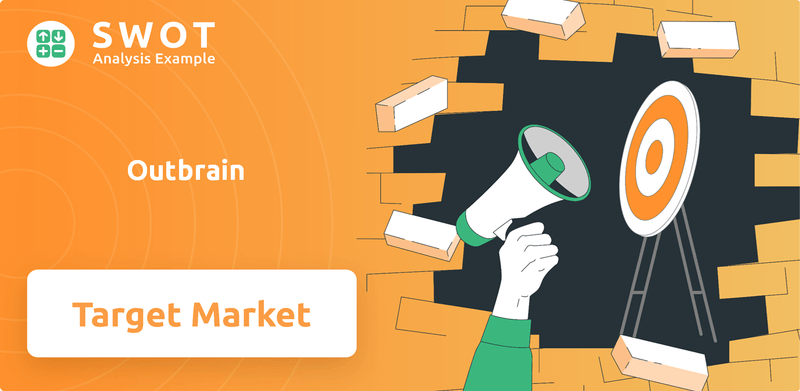
This analysis will explore the evolution of Outbrain's target audience, from its origins in content recommendation to its current status as an omnichannel outcomes platform. We'll delve into Outbrain's customer demographics, including age range, income levels, and geographic targeting options. This exploration will provide valuable insights for advertisers, publishers, and anyone seeking to understand the intricacies of online advertising and content recommendation.
Who Are Outbrain’s Main Customers?
The primary customer segments for the company, now operating under the Teads brand, are media owners (publishers) and advertisers. This B2B model focuses on connecting content with audiences and providing effective advertising solutions. Understanding the customer demographics and the company's target market is key to grasping its business strategy and growth potential.
For media owners, the platform helps to monetize content through personalized recommendations, driving traffic and revenue. Advertisers, ranging from global brands to small businesses, use the platform to promote content and reach a wider audience. The company's focus on both publishers and advertisers highlights its dual-sided market approach within the online advertising ecosystem.
The acquisition of Teads in February 2025, enhanced the company's capabilities to serve enterprise brands, agencies, and mid-market advertisers. This strategic move aims to expand the company's brand advertising and omnichannel video solutions, complementing its expertise in performance advertising.
This segment includes premium publishers and connected TV (CTV) platforms. The company partners with over 10,000 publishers globally. The platform helps publishers increase traffic and generate revenue by displaying personalized content recommendations.
Advertisers range from global Fortune 500 brands to small-to-medium sized businesses. They use the platform to promote their content and reach a wider audience. Approximately 500 advertisers spend $500,000 or more annually. Advertiser spend on the company's DSP grew by about 45% in fiscal year 2024.
The company's customer base includes a significant number of high-spending advertisers. The acquisition of Teads expands the company's offerings, particularly in brand advertising and video solutions. Understanding Outbrain's marketing strategy is crucial for grasping its approach to audience segmentation and online advertising.
- Over 10,000 publishers globally.
- Approximately 500 advertisers spending $500,000+ annually.
- Advertiser spend on the company's DSP grew by approximately 45% in fiscal year 2024.
- Focus on both performance and brand advertising.
Outbrain SWOT Analysis
- Complete SWOT Breakdown
- Fully Customizable
- Editable in Excel & Word
- Professional Formatting
- Investor-Ready Format
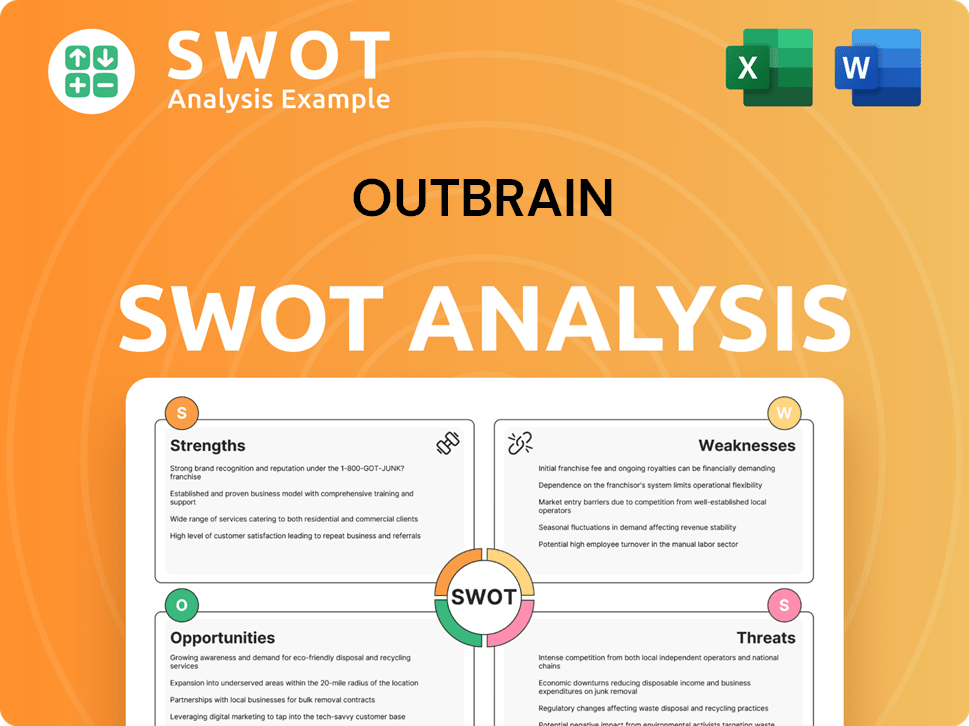
What Do Outbrain’s Customers Want?
The core needs of Outbrain's (now Teads') customers are centered on effective content monetization for publishers and efficient, outcome-driven advertising for marketers. Publishers seek to increase user engagement and generate revenue, while advertisers aim to reach wider audiences, drive conversions, and achieve measurable business outcomes across the open internet. Understanding these needs is crucial for grasping the dynamics of Outbrain's target market and customer demographics.
Advertisers' purchasing behaviors and decision-making criteria are increasingly influenced by the ability to deliver relevant experiences to consumers based on context and interest, especially in a post-cookie environment. Marketers are looking for partners that can identify 'meaningful moments' in the consumer's buying journey. This involves a deeper understanding of audience engagement and behavior to pinpoint when users are ready to discover and evaluate products or services. This shift highlights the importance of attention metrics as a key performance indicator (KPI), measuring genuine engagement beyond simple clicks or viewability.
The company responds to common pain points, such as the need for personalized content delivery, effective audience targeting, and measurable advertising performance. Feedback and market trends, including the shift towards authentic advertising, have shaped product development, leading to offerings like the Engagement Bid Strategy, which leverages dynamic user behavior and intent data to optimize ad delivery. The company also provides a dual model of organic and sponsored content to publishers, integrating recommendation widgets into their sites to increase traffic and engagement. For more insights into the company's evolution, consider reading a Brief History of Outbrain.
Outbrain's target market is defined by the needs of both publishers and advertisers. Publishers need solutions that boost user engagement and generate revenue, while advertisers need to reach their target audiences and improve advertising performance. The company addresses these needs through various strategies and product offerings.
- Publishers: Seek to engage users and monetize their website traffic. They need solutions that enhance user engagement and provide sustainable revenue streams.
- Advertisers: Aim to reach broader audiences, drive conversions, and achieve measurable business outcomes. They are increasingly focused on delivering relevant experiences and understanding audience behavior.
- Advertisers' Purchasing Behavior: Influenced by the ability to deliver relevant experiences based on context and interest. This is particularly important in a post-cookie environment.
- Key Performance Indicators (KPIs): Attention metrics are becoming increasingly important, measuring genuine engagement beyond clicks or viewability.
Outbrain PESTLE Analysis
- Covers All 6 PESTLE Categories
- No Research Needed – Save Hours of Work
- Built by Experts, Trusted by Consultants
- Instant Download, Ready to Use
- 100% Editable, Fully Customizable
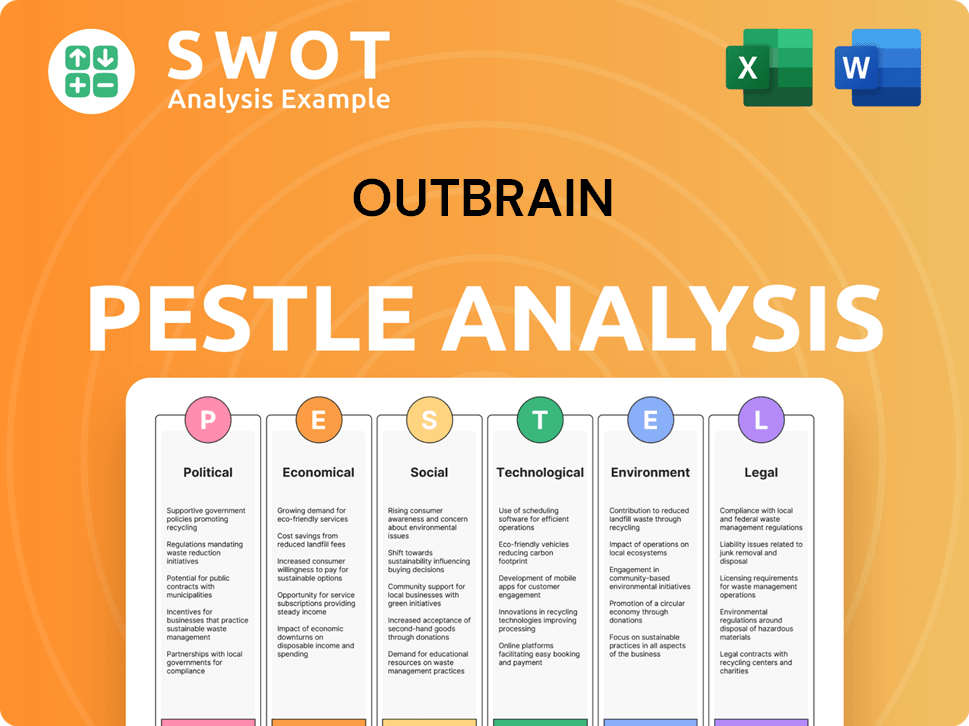
Where does Outbrain operate?
The company, now operating under the Teads brand, maintains a substantial global footprint, reaching more than 50 markets worldwide. Its headquarters are located in New York, New York, with various subsidiaries across Europe, Israel, and Asia. The global team is composed of approximately 1,800 individuals spread across 36 countries, indicating a significant international presence.
The primary geographic areas targeted include Europe, the Middle East, and Africa, followed by the USA and other regions. This extensive reach allows the combined entity to better serve major advertisers seeking a global partner. While specific market share data by country or region for 2024-2025 isn't extensively detailed, the broad presence suggests strong brand recognition and market penetration in these areas.
To effectively address the varying needs of its global customer base, the company employs localization strategies. This approach goes beyond simple translation, incorporating culturally-driven adaptations across all touchpoints, including products, platforms, messaging, and customer experiences. This is essential for success in diverse markets, where consumer habits and monetization preferences can differ significantly.
The company's presence spans over 50 markets, with a strong focus on Europe, the Middle East, and Africa, as well as the USA. This wide reach is crucial for serving global advertisers. The company’s global team consists of approximately 1,800 people across 36 countries.
To cater to diverse customer demographics, the company implements localization. This involves adapting products, platforms, and messaging to fit local market preferences. This approach is vital for success, as consumer behaviors and monetization strategies vary by region.
The company tailors its approach to each region, recognizing that customer preferences and buying behaviors differ significantly. This includes adjusting pricing, packaging, and user experiences to match regional expectations. This approach is critical for the success of the company in different regions.
The company's focus on contextual and interest-based advertising is well-suited for a post-cookie environment. This is a global trend, highlighting the importance of adapting advertising strategies to meet evolving consumer privacy expectations. This approach is crucial for reaching the right Outbrain's target market.
Outbrain Business Model Canvas
- Complete 9-Block Business Model Canvas
- Effortlessly Communicate Your Business Strategy
- Investor-Ready BMC Format
- 100% Editable and Customizable
- Clear and Structured Layout
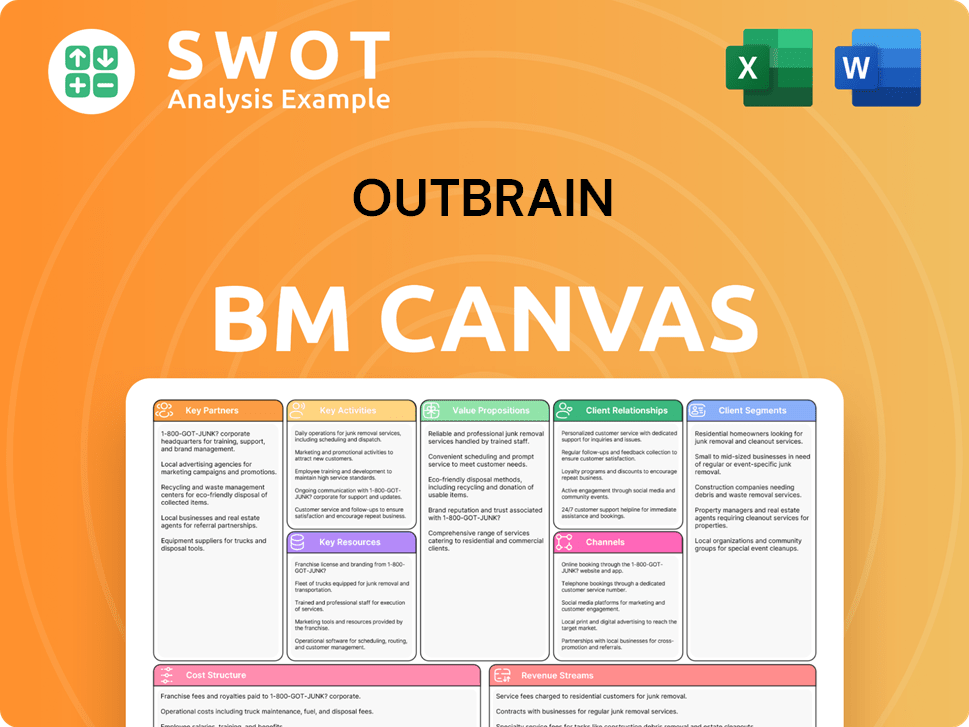
How Does Outbrain Win & Keep Customers?
Outbrain, now operating under the Teads brand, focuses on a dual customer base: publishers and advertisers. The company's approach to customer acquisition and retention leverages a combination of advanced technology and strategic relationship management. Its platform's core function is matching audiences with personalized content and ads, which drives quality engagement for publishers and efficient reach for advertisers. This dual-focused strategy is key to its success in the online advertising sector.
The company directly partners with a substantial number of clients, including over 10,000 publishers and 20,000 advertisers globally. This indicates a robust direct sales and partnership-driven acquisition model. Outbrain's strategies are heavily reliant on data and AI to enhance both customer acquisition and retention efforts. The integration of predictive AI technology allows for highly targeted campaigns and personalized experiences, which are vital for customer loyalty and are essential for understanding the Growth Strategy of Outbrain.
Outbrain's customer acquisition strategy is multifaceted, primarily centered around its content recommendation platform. This platform is designed to connect audiences with relevant content and advertisements, which is a key driver of its customer acquisition. The company's ability to provide value to both publishers and advertisers is a crucial element of its acquisition strategy. The growth in advertiser spend on Outbrain DSP (formerly Zemanta) by approximately 45% in FY 2024 demonstrates the effectiveness of attracting new advertisers and increasing their investment.
Outbrain's core strategy revolves around its content recommendation platform. This approach connects audiences with relevant content and advertisements, thereby attracting both publishers and advertisers. The platform's efficiency in delivering targeted content is a major factor in customer acquisition.
Outbrain's acquisition model heavily relies on direct partnerships and sales efforts. The company directly engages with a large number of publishers and advertisers, fostering strong relationships. This direct approach allows for tailored solutions and effective customer onboarding.
The company leverages data and AI-driven audience targeting to enhance its acquisition and retention efforts. Predictive AI technology is used to connect quality media, brand creative, and context-driven addressability and measurement. This approach allows for highly targeted campaigns.
Outbrain focuses on demonstrating value through performance, which is key to retaining its customers. The company's strategic initiatives, such as the 'Moments' offering launched in Q3 2024, aim to improve audience engagement and provide better outcomes for advertisers. This directly contributes to customer retention.
Outbrain has reported consistent RPM (Revenue Per Mille) growth, a key metric for publishers. The company reported its fifth consecutive quarter of year-over-year RPM growth in the fourth quarter of 2024. This indicates successful monetization strategies.
Advertiser retention is enhanced by delivering measurable results and optimizing campaign performance. The focus on delivering value through efficient reach and targeted advertising helps retain advertisers. Outbrain's success is reflected in increased advertiser spend.
Data-driven strategies and AI-enabled audience targeting are crucial for customer loyalty. The company leverages predictive AI to create highly targeted campaigns and personalized experiences. This approach is key for both acquisition and retention.
Outbrain provides educational content and support to help customers succeed. The company historically focuses on onboarding new customers through educational emails and webinars. This approach enhances product usage and reduces churn.
Communicating product improvements and new features is essential for keeping customers engaged. Lifecycle email marketing helps keep customers informed and engaged with the latest updates. This helps maintain customer satisfaction.
Loyalty programs and personalized offers are effective retention strategies. These incentives encourage repeat business and build emotional connections with customers. This helps foster long-term relationships.
Outbrain Porter's Five Forces Analysis
- Covers All 5 Competitive Forces in Detail
- Structured for Consultants, Students, and Founders
- 100% Editable in Microsoft Word & Excel
- Instant Digital Download – Use Immediately
- Compatible with Mac & PC – Fully Unlocked
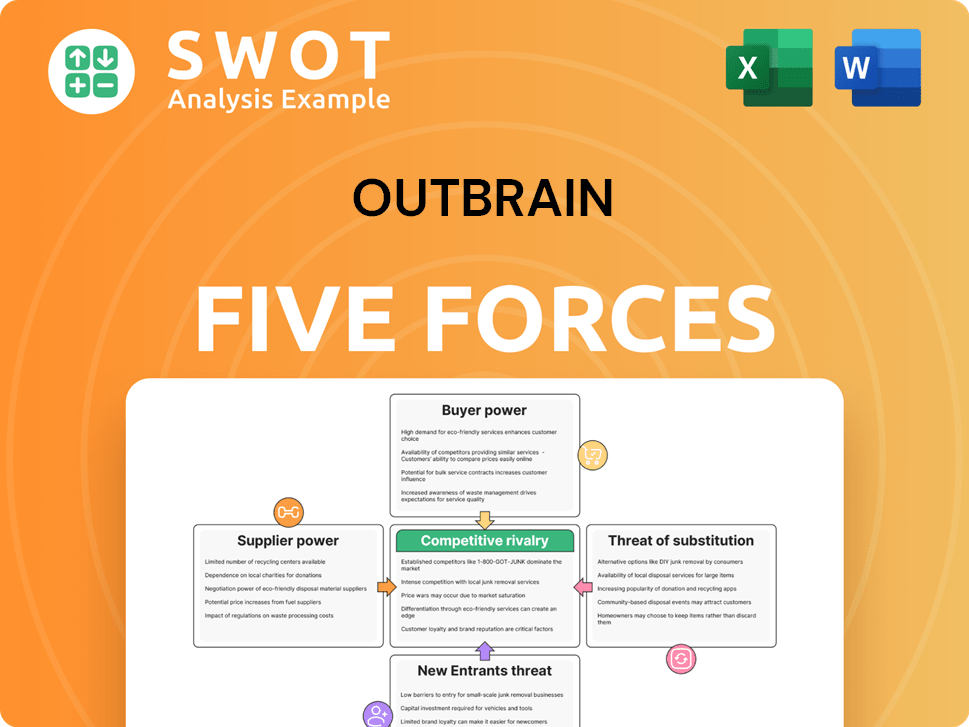
Related Blogs
- What are Mission Vision & Core Values of Outbrain Company?
- What is Competitive Landscape of Outbrain Company?
- What is Growth Strategy and Future Prospects of Outbrain Company?
- How Does Outbrain Company Work?
- What is Sales and Marketing Strategy of Outbrain Company?
- What is Brief History of Outbrain Company?
- Who Owns Outbrain Company?
Disclaimer
All information, articles, and product details provided on this website are for general informational and educational purposes only. We do not claim any ownership over, nor do we intend to infringe upon, any trademarks, copyrights, logos, brand names, or other intellectual property mentioned or depicted on this site. Such intellectual property remains the property of its respective owners, and any references here are made solely for identification or informational purposes, without implying any affiliation, endorsement, or partnership.
We make no representations or warranties, express or implied, regarding the accuracy, completeness, or suitability of any content or products presented. Nothing on this website should be construed as legal, tax, investment, financial, medical, or other professional advice. In addition, no part of this site—including articles or product references—constitutes a solicitation, recommendation, endorsement, advertisement, or offer to buy or sell any securities, franchises, or other financial instruments, particularly in jurisdictions where such activity would be unlawful.
All content is of a general nature and may not address the specific circumstances of any individual or entity. It is not a substitute for professional advice or services. Any actions you take based on the information provided here are strictly at your own risk. You accept full responsibility for any decisions or outcomes arising from your use of this website and agree to release us from any liability in connection with your use of, or reliance upon, the content or products found herein.